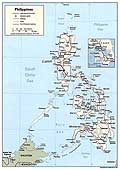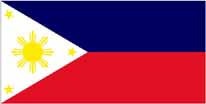-
-
- Philippines Map
|
-
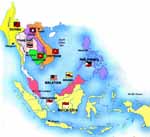
-
- Map of
- Southeast Asia
|
|
-
|
- latest picture: February 1, 2011
|
- Island of Bohol 1/14 -
1/19/2011
|
-
- When we land in Tubigon arriving from Cebu the downpour
continues and right then our windshield wiper stops working. Memories from Norway come
alive. There, we improvised by tiding a string on both wipers and pulling it alternately
from the side windows. Here, however, we get around it, as the rain stops abruptly and the
sun is shining again when we drive past the beautiful blue “St.Vincent Ferrer”
Church in Calape. In its church park there are still creatively made Christmas trees of
empty plastic bottles, lids and all kind of recycling material.
|
-
-
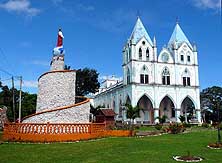
|
-
-
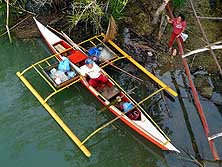
|
-
-
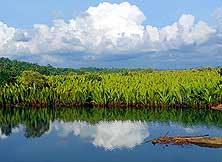
|
- 236
The beautiful pale blue
- “St. Vincent Ferrer” Church in
- Calape in the West of the island
- is one of Bohol’s attractions
|
- 237
A little break and some
- gossip under a bridge
|
- 238
A dense Nipa palm forest lines
- a river bank. Roofs and walls of the
- traditional Nipa huts are made
- from the strong Nipa palm leaves
|
-
- Heading south, lush green rice fields pop up again. Where rivers are favored by the
tides of the sea, dense Nipa palm forests line their banks. Nipa palms are robust and used
for building the walls and roofs of the traditional Nipa huts. Towards the evening, we
reach the capital Tagbilaran and take a room at the hotel Sun Avenue for Peso 1’150
(US$26), including breakfast. In the evening we shop in the supermarket at the mall and
poke around in the many shelves. Suddenly church bells sound from the loudspeakers.
What’s going on? We look at the watch. It is 6pm. Like by command, the cashiers are
kneeling down, shoppers cross themselves and remain in prayer for around five minutes. It
is the first time that we experience this in a Christian area. For example, if the muezzin
calls for prayer in Saudi Arabia we know that shutters are lowered and shops close for at
least half an hour.
|
-
-
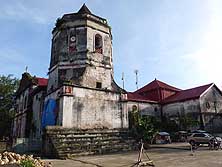
|
-
-
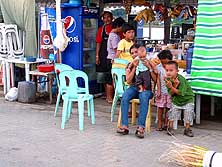
|
-
-
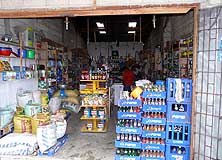
|
- 239
The old church in Maribojoc of
- the Spanish colonial area needed also
- a renovation – like many others too
|
- 240
Children at the seashore at
- Tagbilaran, the capital of Bohol
|
- 241
A typical village shop
|
-
- Next day is dedicated to the island of Panglao – a famous tourist area –
connected by two bridges with the “mainland”, the main island of Bohol. Here the
contrast between poor and rich could hardly be starker. We drive past modest Nipa huts,
where six people live on a confined space of 3x3 yards without electricity and water
supply, and mostly also without toilet. Not far away is the Alona Beach with the expensive
hotels and restaurants and the omnipresent dive centers. These establishments seal off
completely any access to the beach. Only those who are prepared to pay consumption are
allowed to pass. The only remaining option is parking the vehicle somewhere and search for
a beach access by foot. Being not our world anyway and additionally being incredibly hot,
it does not upset us. We hop into our LandCruiser again and drive towards the hills. There
we find soon a spot in the nature just for ourselves. It not only provides us with shade
and quietness, but also with a splendid view to the sea and towards the main island.
|
-
-
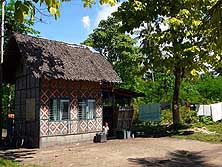
|
-
-
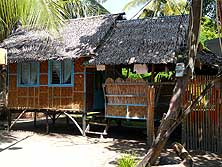
|
-
-
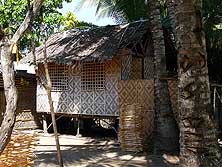
|
- 242
|
- 243
|
- 244
|
- Different kinds of Nipa huts on Panglao Island, the famous seaside resort.
- Extended families often live cramped together in tiny rooms, mostly without running
water and power
|
-
- The day afterwards, we leave the capital behind us and drive towards the East. Soon we
arrive at the mighty Loboc River. From the bridge we watch the floating restaurants,
packed with mostly local tourists, being pushed upriver by a tug. Lightheartedly we can do
it without joining and set off to the interior. Our goals are the two main attractions of
this island: The endemic and endangered Tarsiers in Loboc, the second smallest primates in
the world and the Chocolate Hills in the village of Carmen with its 1’268 hills.
|
-
-
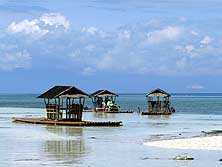
|
-
-
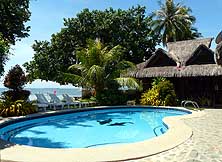
|
-
-
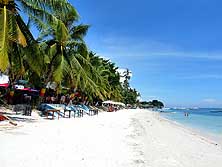
|
- 245
Floating pavilions at a luxury
- hotel complex in Panglao …..
|
- 246
..... the setting of the
- 'Bita-ug Beach Resort',
- directly on the beach …..
|
- 247
..... and the famous Alona Beach in
- Panglao in the South of the island with its more
- expensive hotels, restaurants and diving centers
|
-
- Shortly after the Loboc tourist complex, we follow a sign “Tarsiers” into a
small leafy enclosure and peer around. Initially we do not see anything. Only when we
check very carefully, we spot the first and then the second of these tiny primates
clinging on to a thin tree branch. They are hardly as tall as a fist and have enormous
eyes. It warms my heart and I cannot find any words to describe my overwhelming feelings
at the sight of these cute tiny creatures. Actually, they are nocturnal, but to satisfy
the tourists, they are shown by day and with the donation box, the business flourishes. We
also feed the container, but with really mixed feelings.
|
-
-
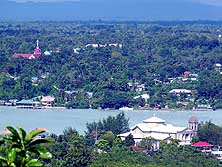
|
-
-
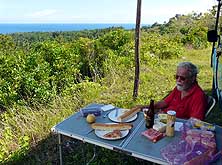
|
-
-
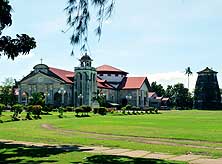
|
- 248
Lovely view from our picnic
- spot on a hill on the Panglao Island
- towards Tagbilaran on Bohol …..
|
- 249
….. Emil is enjoying the view
- and looking forward to our picnic
|
- 250
In the village of Panglao
- there is an impressive cathedral,
- surrounded by a well groomed park
|
-
- Doing it, we are also contributing to this illegal prospering business. Apparently
attempts to stop it are on the way – but as corruption has a long tradition ......
Kept well and fed well (they are insect eaters), tarsiers live about 12 months in
captivity. In their natural environment however up to 24 years! In addition, their life
expectation is reduced due to shocking treatment because of their fragile bones. Despite
of the sign at the entrance “Handling strictly forbidden” we watch how a group
of youngsters do not give a damn about directions and the attendant turns a blind eye to
it – the donation box stands besides!
|
-
-
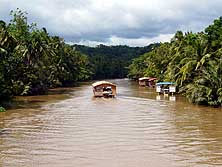
|
-
-
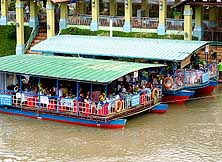
|
-
-
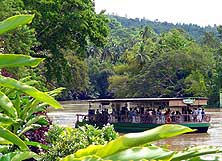
|
- 251
A floating restaurant is pushed
- up the Loboc River by a tug
|
- 252
Floating restaurants parked at
- the tourist complex in Loboc,
- crammed with mostly local tourists
|
- 253
The banks of the Loboc
- River look really very tropical
|
-
- It is time for our lunch picnic. Not finding a proper spot, we proceed to the
“Chocolate Hills” in Carmen, which turns out to be fortunate as shortly
afterwards rain starts. The “Chocolate Hills” owe their name to their brownish
appearance during the dry season. Today however, after the continuous rain of the last
weeks, they are covered with a fresh green. It is a modest entry fee (Peso 100 = US$2.20
for two persons) that we pay to drive to the view point and to climb the many steep steps
to the platform. Though the sight is not necessarily overwhelming, the 1’268 almost
identical hills, each between 160ft. to 400ft. high, are still a peculiarity. They
certainly attract crowds of tourists.
|
-
-
-
-
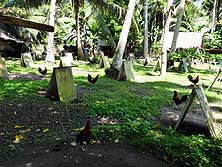
|
-
-
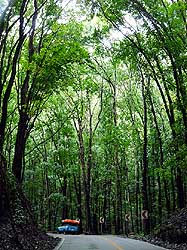
|
-
-
-
-
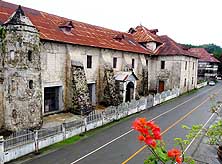
|
- 254
The cocks trained for the
- famous cockfights (Sabong) are looked
- after very well. Each one has its own shed
|
- 255
Between the villages of Loboc
- and Carmen in the center of the island,
- we drive through a beautiful forest
|
- 256
The old church in Loboc is the
- attraction of the village, but needed
- also some cleaning
|
-
- We spend the night in this region hoping that the Chocolate Hills will be at their best
early morning – wishful thinking! Already during the night it continued to rain and
didn’t stop in the morning. “Adorned” by fog, some of the hills show
themselves only dimly. Others appear for a few seconds to disappear in the mist again
– a different experience from yesterday. We reached here in the center of Bohol
definitively the border of the Northeast monsoon’s influence.
|
-
-
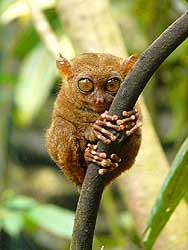
|
-
-
-
-
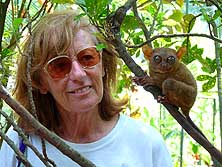
|
-
-
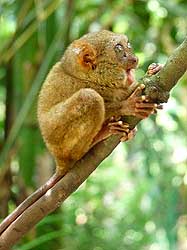
|
- 257
In Loboc we see our first
- Tarsier, hardly as big as a fist,
- with enormous eyes,
- being a nocturnal animal .....
|
- 258
Liliana hardly can see
- enough of these cute primates
|
- 259
If Tarsiers are looked after and fed
- well (they eat actually only insects), in
- captivity they live maximum 12 months; in their
- natural environment however up to 24 years!
|
-
- There are only ten days left until the containerization of our LandCruiser in Subic Bay
on the island of Luzon has to take place. It is time to get slowly on our way. While we
were never sure about our return trip, today it becomes definitively clear: We cancel our
earlier plan to return through the Eastern islands of Leyte and Samar and will head back
to the mainland the same way instead, using the “Strong Republic Nautical
Highway” for the second time. However this involves five ferries instead of only two.
What made us change our mind? It is the Northeast monsoon that this year is much stronger
than in the past. Already since weeks the whole of the Eastern Philippines is subject to
continuous rain, flooding and land slides and there is no end in sight. Furthermore nobody
is able to give us competent information about the road conditions: Are they passable at
all – particularly the bridges; are the landslides cleared; are there some stretches
flooded; is there at all a chance to get through? Being tied to a date, it is simply too
risky.
|
-
-
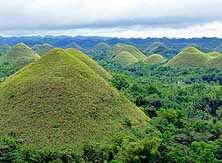
|
-
-
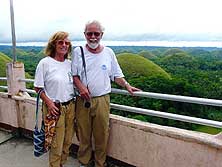
|
-
-
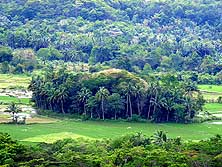
|
- 260
The ”Chocolate Hills“ in Carmen
- include on an area of about 20 sq.mi.
- up to 1’776 scattered, almost identical
- hills, between 100 and 390 ft. high.
- They owe their name to their brown
- look in the dry season
|
- 261
A remembrance picture of
- our visit to the “Chocolate Hills”
|
- 262
View of paddies and palm groves
- from the “Chocolate Hills” viewing point
|
-
- Two rivers that yesterday flowed peacefully through the central highland of Bohol have
risen dramatically over night. Parts of rice fields are under water. Ourselves, we are
also affected from the rain. Despite repairing our wiper only a few days ago, it stops
working again. Now there is only our emergency solution: To tie a string on both wipers
and pull it alternatively from the windows – by the way: It works perfectly. Back in
Tagbilaran, the streets are teeming with people in blue uniforms. Armed military is
patrolling. What is happening? Only when we check our emails, we know the reason: Romanus
from Sipalay writes that a terror warning has been issued for the island of Bohol. Not
that we are panicking, but it makes our tomorrow’s farewell from this lovely island a
bit easier.
|
-
-
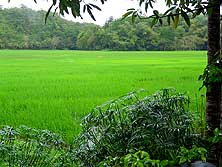
|
-
-
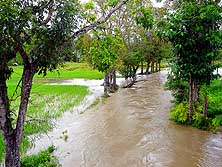
|
-
-
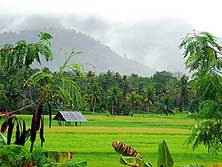
|
- 263
Green, green, green after the
- continuous rains – a rice field in
- the Loboc region
|
- 264
Heavy rain during the night
- made the river to overflow and
- inundate part of the rice fields
|
- 265
A mystic morning after
- a night of heavy rain in Loboc
|
-
- Our return to the departure island of Luzon – exactly to Subic Bay – takes
place in five days with five ferries through five islands. Here a short description:
1st Ferry: From Tubigon/Bohol Island to Cebu City/Cebu Island:
The sea journey to Cebu City takes two hours on a calm sea. From Cebu City in the East we
cross the island on a new, little spectacular route to the West, to Toledo. We stay the
night at Toledo and next morning at 6am, we are already at the port where Emil is
struggling with a sleepy unfriendly guy at the ticketing booth of the Lite Line. He does
not want to accept our foreign vehicle registration and therefore doesn’t want to let
us board, insisting that he has the competence to deny it. In the meantime, a uniformed
lady from the agricultural department shows up at our car looking for plants. Always
something new: Either didn’t happen before in the Philippines. At the end, the guy at
the ticketing office backs down and at 7.30am we are on board.
2nd Ferry: From Toledo/Cebu Island to San Carlos/Negros Island:
The crossing time is two hours. For the next ferry connection, it is necessary also here
to change from the East coast to the West coast, from San Carlos to Bacolod. We choose
again the route crossing the island through the hills, branching off South of San Carlos.
It is a lovely ride with lovely views. We stay the night in Bacolod at the same place as
on the outward journey.
3rd Ferry: from Bacolod/Negros Island to Dumangas/Panay Island:
We take the 10am ferry. The crossing lasts two hours. Again we have to switch port for the
next ferry: From Dumangas overland to Caticlan, from the Southeast to the Northwest.
Instead of following the coastal road, we take the route through the flat interior,
passing mainly through wide rice paddies. We spend the night in Kalibo, 40 miles East of
Caticlan.
4th Ferry: From Caticlan/Panay Island to Roxas/Mindoro Island:
This crossing lasts 3½ hours. The ocean is calm again. From Roxas in the Southeast we
have to change to the ferry terminal of Calapan in the Northeast, unfortunately we have to
drive on the same awful construction road (Emil counts 10 different construction sites) as
outward bound. We sleep in Calapan once more at the same location.
5th Ferry: From Calapan/Mindoro Island to Batangas/Luzon Island:
At 10am we board the Montenegro-Ferry – the best in the Philippines – back to
Batangas on the main island of Luzon. Immediately we continue to the Taal Crater Lake,
where we stop one day to relax and take in the fresh air of the Tagaytay hillside.-
|
- Luzon (South) 1/23 -
2/1/2011
|
-
-
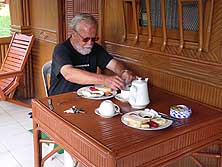
|
-
-
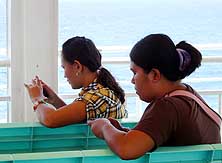
|
-
-
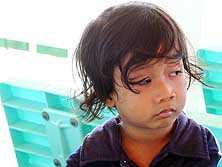
|
- 266
Emil at breakfast in Calapan
- before we cross over
- to Batangas on Luzon
|
- 267
A common sight: “Playing” with
- the mobiles everywhere –
- there is a lot of time on the ferry
|
- 268
What is this little passenger
- possibly thinking about?
|
-
- Expecting mail at our embassy in Makati, a quarter in Manila City, we cannot delay our
visit to the mega town any longer. Unfortunately, the CD’s of our radio and TV
interviews from Switzerland and Germany didn’t arrive. But we have the honor to be
invited by our Ambassador, Mr. Sieber, for a cup of coffee and spend an hour in an easy
conversation with him.
|
-
-
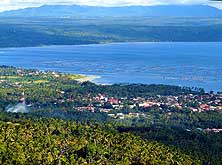
|
-
-
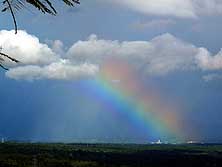
|
-
-
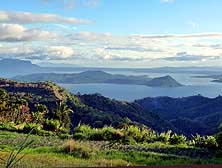
|
- 269
View from Tagatay to the village of
- Talisay at the Taal Crater Lake – Tagatay is
- popular with weekenders from Manila …..
|
- 270
..... in the distance an
- impressive rainbow is forming …..
|
- 271
..... the crater lake presents
- itself very peacefully
|
-
- Not being tempted to remain longer in Manila, we leave this congested city behind us and
are happy when we are safe on the highway to the North. Was it intuition? Only one hour
later we would have been caught in the traffic chaos on the EDSA road in the Makati
business area, when a terrorist attack on January 25th, 2011, targeted on a bus left five
people dead.
|
-
-
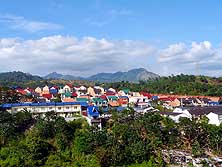
|
-
-
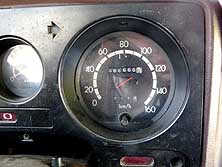
|
-
-
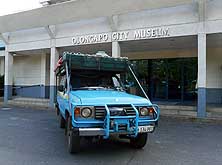
|
- 272
A new settlement along the
- express road from Clark to
- Subic Bay catches our eyes
|
- 273
In Olangapo, the neighboring
- town of our shipping port Subic Bay,
- the odometer of our LandCruiser reaches
- the special figure of 666’666.6 …..
|
- 274
….. exactly in front
- of the City Museum
|
-
- Early afternoon, we already reach Olangapo, the busy “border town” near Subic
Bay, which is our shipping harbor. A unique moment is waiting for us right in front of its
museum: Our odometer reaches kilometer 666’666.6 – what a lovely figure (=
414’247 miles)! Thanks to Emil’s accurate statistic, we immediately know where
we celebrated our 555’555.5 km. It was in Panama on August 5th, 2001. Two hours
later, on the terrace of the Rama Beach Resort, we toast to it with a beer or two just
when the sun sets behind the ocean with a beautiful red ball. We are now at the Zambales
Coast, 5 miles South of Botolan.
|
-
-
-
-
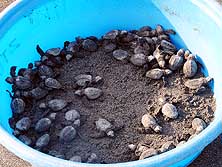
|
-
-
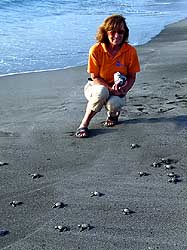
|
-
-
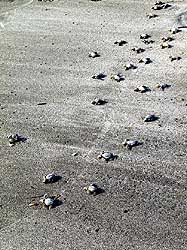
|
- 275
At the ‘Ramo Beach Resort’,
- 6 miles short of Botolan at the West
- Coast, small leatherback turtles
- (Dermochelys coriacea) have
- hatched after an incubation
- time of 24 days …..
|
- 276
….. Liliana watches how the hardly
- 4 inches long babies intuitively crawl
- towards the sea. We could watch back
- in April 2003 in Saint-Laurent-du-Maroni
- in French Guiana how the big turtles
- returned to lay their eggs
|
- 277
Only a quarter will survive
- their first phase of life. Birds,
- stray dogs and in the sea fishes
- are during this stage their
- major predators
|
-
- During the night, after 24 days of incubation, tiny Leatherback turtles have hatched at
the enclosure of the Beach Resort. Roger, the Australian manager has specifically waited
for us before releasing them onto the beach. We watch how these hardly 4 inch small babies
intuitively crawl towards the sea. Some of them are returned by the waves and land in the
sand on their back, sometimes even more than once. Each time, it needs a lot of energy for
them to get back on their flippers. We assist them in the first phase of their life and
wait until we are sure that all of them are at least safe in the water.
|
-
-
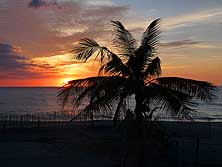
|
-
-
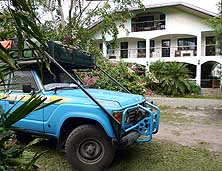
|
-
-
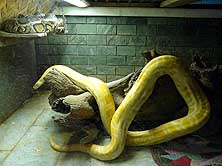
|
- 278
Sunset at the “turtle beach” of
- the ‘Ramo Beach Resort’ near Botolan
|
- 279
We park our LandCruiser in front
- of the ‘Botolan
Wildlife Farm’ of Martin
- Zoller from Switzerland, situated at the
- Zambales coast. We visited him already
- without our car in February 2008 while
- transiting from Hong Kong to New
Zealand
|
- 280
The Burmese albino snake is
- one of the animals at this well kept
- wildlife farm. On the upper left
- side a “normal colored” Burmese
- Python (Python morulus) is visible
|
-
- Only 4% will survive. Their main predators are humans, birds, straying dogs and fishes.
Here, they are at least safe from the first three. What then happens in the sea, we cannot
influence anymore. We are very happy about this unexpected experience. It completes the
one we had in April 2003 in French Guiana where at night,
equipped with a torch, we could watch the Leatherback turtles landing, digging their hole
and laying their eggs.
|
-
-
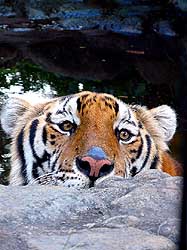
|
-
-
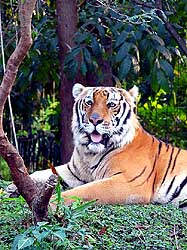
|
-
-
-
-
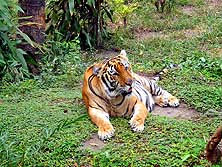
|
- 281
|
- 282
|
- 283
|
- The star of the lovely zoo is „Ramses“, a Sibirian Tiger (Panthera tigris
altaica) –
- a beautiful wild animal, raised by Martin and his family. Today, “Ramses” is
five years old
|
-
- We are looking forward with great anticipation to see „Ramses“, the Siberian
Tiger, when two days later we move on to the Botolan Wildlife Farm. Already two years ago,
we visited this place when we explored Northern Luzon
without our LandCruiser. And again it is marvelous to see this beautiful wild animal, the
star in the small zoo of Swiss Martin Zoller, right in front of us. We watch him for hours
and are always pleased, when he comes towards us with his special “grunting”,
showing us that he likes our company. In the tropical garden with all the well kept animal
enclosures and tropical flowers we can relax wonderfully. There are owls, monkeys,
ostriches, deer, snakes, a crocodile and many different birds.
|
-
-
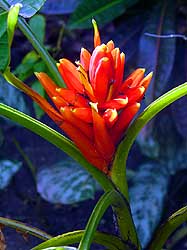
|
-
-
-
-
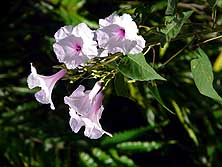
|
-
-
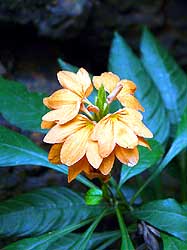
|
- 284
|
- 285
|
- 286
|
- All kind of beautiful tropical flowers bloom in Martin’s “zoo garden”
|
-
- The accommodation is clean and of good value. And Grace, Martin’s daughter, is an
excellent cook. We spend many hours in Martin’s company and get many things confirmed
about the Philippines’ way of life. He also tells us many anecdotes about
people’s reaction when he suddenly appeared with then still young “Ramses”
in a restaurant or when he took him for a ride in a boat. With his help, we also find the
urgently needed spare part for our broken wiper. Everything is just perfect for us here in
this little oasis. Therefore we decide to return to Subic Bay – two hours driving
time away – only at the day of containerization of our LandCruiser, on Monday,
January 31st.
|
-
-
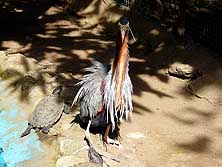
|
-
-
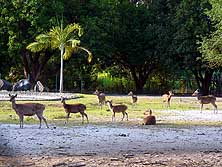
|
-
-
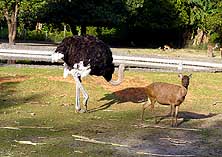
|
- 287
The proud Purple Heron (Ardera
- purpurea) lives in harmony with the turtles
|
- 288
During the fresher evening hours,
- the game becomes active again
|
- 289
An ostrich (Struthio camelus)
- and a deer (Cervus mariannus) roam
- inside the spacious deer enclosure
|
-
- On Sunday, January 30th, our peace gets suddenly unexpectedly interrupted. From our
broker we get surprisingly an SMS with the bad news that there is no container available
on the following day. How can this happen? We ordered it already on January 3rd, which was
confirmed. Additionally, we checked again by phone when we were in Manila on January 25th,
if everything was OK, which was confirmed again. After having sent around some emails to
the responsible people, we get on Monday morning at 8.30am the reassuring news that the
container is now on its way from Manila to Subic Bay. This makes us leaving to Subic Bay
too to meet the box coming from the opposite direction. Little did we know by then what
the agent in Manila had still in store for us.
|
-
-
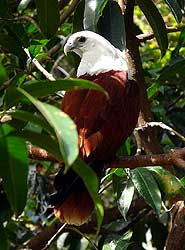
|
-
-
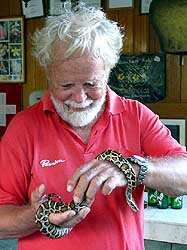
|
-
-
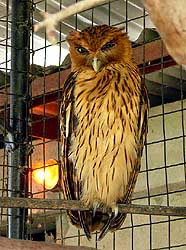
|
- 290
One of the seven beautiful
- eagles in the aviary
|
- 291
Emil is not scared to
- pet a Burmese python baby
|
- 292
It is early morning: The Philippine
- Eagle Owl (Bubo philippinensis) is
- sleepy and closes slowly its eyes
|
-
- While driving to Subic Bay the phone rings at 11.30am. Manila is on the line with the
upsetting news that – contrary to the morning confirmation – our container is
not yet on its way because they first need our agreement that we will take over the
transport costs of US$409. Are they really being serious? We go ballistic!
|
-
-
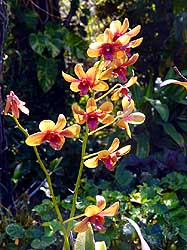
|
-
-
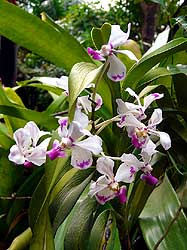
|
-
-
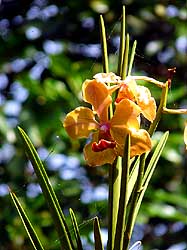
|
- 293
|
- 294
|
- 295
|
- The biodiversity of orchids in the zoo garden is enormous
|
-
- But being under extreme time pressure (tomorrow Tuesday early in the morning, we booked
our flight to Singapore), there is nothing else we can do
than give our OK; it looks like extortion. Next we are informed that the container is now
released and will leave Manila at 2pm. May be it still works out; four hours of trucking
from Manila to Subic Bay should be OK! We cling to it, because the port authorities
generously allowed us in the meantime to stuff and lash our LandCruiser in the port until
10pm.
|
-
-
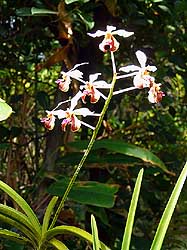
|
-
-
-
-
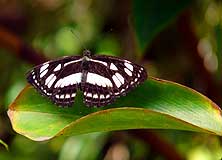
|
-
-
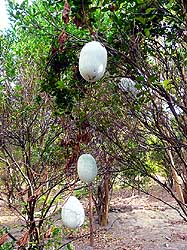
|
- 296
Another blooming orchid
|
- 297
A butterfly, attracted by the
- many flowers, rests on a big leaf
|
- 298
A weird sight: pumpkins
- dangling from droughty bush branches
|
-
- At 4pm however, also this last hope breaks up definitively. We get the message that the
container will arrive here only after 10pm – container trucks are allowed to
circulate in Manila only after 6pm due to traffic disturbances – definitely too late
to arrive in time in Subic Bay! This means that we will miss our budget flight of tomorrow
Tuesday, 7.45am from Clark Airport to Singapore, of course without any refund possibility.
|
-
-
-
-
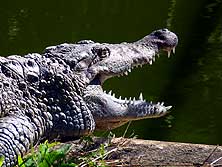
|
-
-
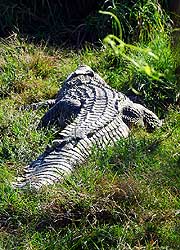
|
-
-
-
-
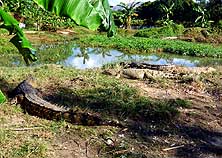
|
- 299
Head of a „Crocodilus Mindorensis“
- at Kitsie’s Farm in Ibo – a fresh water
- crocodile found only in the Philippines. It
- belongs to the critically endangered species
|
- 300
An impressive saltwater
- crocodile (Crocodilus Porosus)
- at Kitsie’s Farm in Ibo …..
|
- 301
..... these salt water crocodiles
- live in a natural environment
|
-
- The following morning at 8am we find ourselves again in the office of our broker. Our
container has arrived during the night. “If we are very lucky, it may work out
now” Emil argues when we follow Mrs. Dang from the broker office to the Subic Bay
Container Terminal. He got out in the office that it needed a permit to stuff our car
within the port and apparently Soriamont in Manila has omitted to apply for it. But Mrs.
Dang does a good job and the port staff is cooperative (with one-two bottles of whisky).
Like in a lot of other places, also here many eyes are watching how Emil drives the car
carefully into its 21st box and lashes it professionally. “See you again in Sri Lanka!”
|
-
-
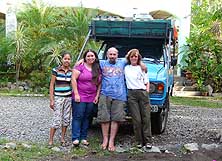
|
-
-
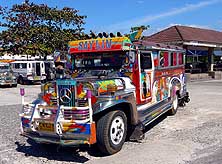
|
-
-
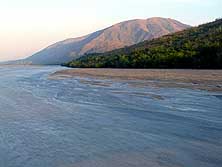
|
- 302
Farewell-picture of Martin, his
- daughter Grace (besides him) and the
- housemaid of the ‘Botolan
Wildlife Farm’,
- where we spent a couple of relaxed days
|
- 303
A fancy painted jeepney
- in Iba – the main mean of public
- transport in the Philippines
|
- 304
The wide river and the landscape
- near Botolan have a touch of Alaska
|
-
- In the afternoon, we are sitting in the air-conditioned bus to Clark Airport – we
still got hold of two seats on the 4.10pm flight of the Philippines Seair to Singapore. During the bus journey, we ask ourselves: “Did
the enormous financial effort and the time consuming bureaucracy war pay off? The visit of
the Philippines became up to now our most expensive one, mainly due to the disproportional
port charges – was it worthwhile? For Emil it is more than questionable, because we
explored the most attractive region, Northern Luzon, with
its colonial master pieces and the man-made rice terraces already in 2008, back then
without our LandCruiser but with a rented car.
|
-
-
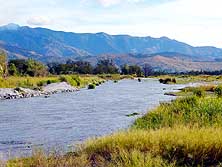
|
-
-
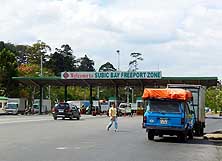
|
-
-
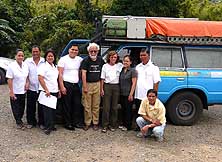
|
- 305
The landscape along the West
- coast in the province of Zambales is
- rather dry compared with other regions
|
- 306
We park in front of the ‘Subic
- Bay Freeport Zone’, which we left
- on November 11th, 2010. The war
- of bureaucracy starts
|
- 307
Customs Officer and Gate personnel
- are eager to have a picture taken with our
- LandCruiser. The lady with a bunch of papers
- is Mrs. Dang, the broker, who showed the
- most engagement to get our car released
|
-
- My feelings differ somehow: I remember the small islands in the South with its colorful
outrigger canoes, the peaceful life of the fishermen families, the modest Nipa hut
villages, the fresh green of the rice fields, the white and black sandy beaches, the old
Spanish churches, the tiny Tarsiers on Bohol Island and the friendly, but reserved people.
Yes, I admit it was not necessarily outstanding, rather lovely and neat, but I would not
like to miss it!
|
-
-
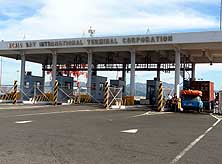
|
-
-
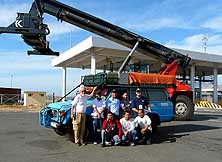
|
-
-
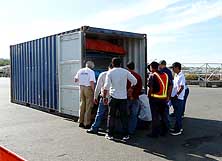
|
- 308
End of our Philippine journey:
- Our LandCruiser is now ready to enter
- the Subic Bay International Terminal
|
- 309
Customs Officers and Terminal
- employees are keen to have a photo
- taken with our LandCruiser
|
- 310
A last look of our trusty buddy caged
- in its 21st container before he starts his
- long sea journey to Colombo in Sri Lanka
|
-
|
-
- More websites from the Philippines:
- 2nd Visit – Part
1: Luzon (South) – Islands of Mindoro –
Panay with our vehicle from November to December
2010
- 2nd Visit – Part
2: Islands of Negros – Cebu
with our vehicle from December 2010 to January 2011
- 1st Visit to the
Philippines: Luzon (North) without vehicle in February 2008
|
![]()
